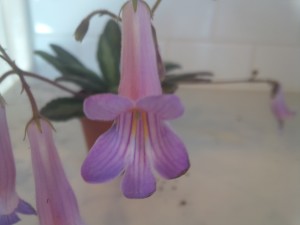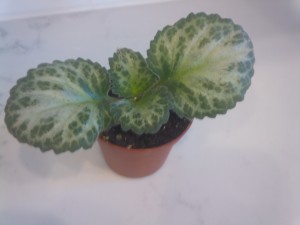
The other day I felt the familiar pangs of plant love at first sight. This has happened often over the years because I have a fickle heart and endless curiosity about beautiful and unfamiliar plants. Most of the time these sudden crushes result in good plant acquisitions. A few have turned out badly, but I can’t dwell on that, because doing so might make me wary about starting the next delightful plant love affair. Sometimes you just have to take risks.
The object of this week’s passion is primulina. This sounds like either a baby primrose or the love child of a primrose and some other, closely related species. It is neither of those things and, in fact, a primulina is not a primrose at all. In the world of familiar plants, it is most closely related to African violets and is a fellow card-carrying member of the gesneriad or Gesneriaceae family.
My new primulina caught my eye when I was looking over a display of African violets at Longwood Gardens, one of the epicenters of the horticultural world. The gift shop there was full of enticing plants, but I wanted to ring in the New Year with something small and easy to manage.
At first glance, I thought the little primulina, nestled in a 2.5 inch pot, was a variegated African violet. Its fuzzy, rounded leaves, adorned with rippling cream striations, looked very violet-like. I didn’t know that the little plant was anything different until I looked at the plant tag, which read “Asian Violet” in large letters and “Primula ‘Loki’” in smaller ones. I was intrigued and decided that the small cost of the little primulina would more than justify the leap of faith that I would take by buying it.

Plant research is almost as much fun as plant cultivation and when I got my primulina home, I delved into its background. The plant tag was correct; primulinas are native to tropical Asia, including parts of China, Indonesia, Vietnam, Sri Lanka and Thailand. While the plants have always been gesneriad family members, they have not been called “primulina” for long. The genus used to go by the name “Chirita”, until plant taxonomists decided that most Chiritas should be transferred to a new species. “Primulina” came into being.
Had I seen my plant, which goes by the varietal name, ‘Loki’, in flower, I would have known that it is no African violet. The flowers, which rise above the leaves on three-inch stems, are elongated and tubular, looking more like streptocarpus flowers than African violet blooms. ‘Loki’ bears blue flowers, but primulina cultivars are available in traditional African violet colors, including shades of blue, blue-purple, purple, pink and yellow or cream. Some are bi-colors, with contrasting throats or markings. Whatever the color, the blooms are graceful and lovely.
African violets and primulina are both beautiful, but gesneriad family experts report that the latter bloom more often. Combine that trait with the fact that the leaf variegation makes them appealing when not in flower, and you have the makings of a commercial winner. Add in ease of care and it would appear that in a few years, the former chiritas will be on every retailer’s African violet shelf.
‘Loki’ is a hybrid plant, as are many of the primulinas on the market. Depending on the parent plants’ traits, primulina leaves may be rounded or elongated. My daughter, who was bitten by the same plant-acquisition bug as I, purchased, ‘Rachel’, a variety with purple flowers and long, lance-shaped leaves. Some plants feature unadorned green foliage, but most of the commercially available hybrids bear the characteristic variegation.
Until primulinas become horticultural superstars, they will travel in the company of African violets. My plant and many other popular varieties were hybridized by Peter Shalit, a former president of the Gesneriad Society, the interest group for lovers of African violets, streptocarpus, gloxinia and related species. A look at several retailers’ websites suggests that Shalit is responsible for a number of very attractive hybrids.
If you can keep an African violet alive, you can provide the kind of enlightened neglect that will result in thriving primulina. The plants prefer bright, indirect light. Restrain yourself when watering and wait until the top of the soil is somewhat dry to the touch. Try not to get water on the leaves. Overwatering will cause crown rot, just as it does with African violets. Feed your primulina with a diluted fertilizer recommended for African violets. If you want to propagate a desirable plant, pluck off a leaf and insert the petiole or stem end in moistened potting medium. Water sparingly as needed, and in a month or so, a new plantlet will form.
Young primulinas, like mine, may take up to a year to flower, but be patient, the wait is worthwhile and the foliage is entrancing. In the meantime, install your primulina in a small container, dish garden or terrarium and pat yourself on the back for being the first in your neighborhood to own one.
If you want to delve into the primulina world, seek out the excellent selection at Lyndon Lyon Greenhouses, PO Box 249, Dolgeville, NY 13329-0249; (315) 429-8291; www.lyndonlyon.com.
